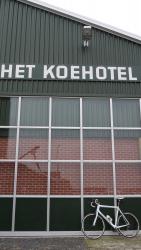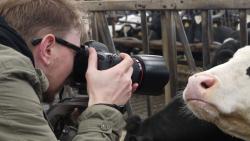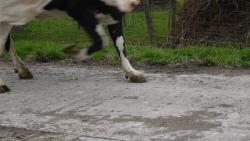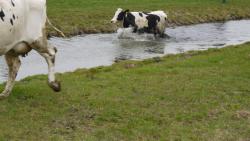‘They can’t stop working’cause you’re here,’ half-jokes Andy Barker, the persuasive American Social Mission Specialist for Ben & Jerry’s. Either side of press and students and NUS student representatives imported from Finland, Germany and the UK, ruminating cows freely and flagrantly – but far from fragrantly – pass liquids and solids. Meanwhile, a mean wind threatens to tear-free the corrugated roof which hazily filters the grey gleam onto our long trestle table. At this those with a steady constitution sip small cups of soup and bite into firm, not crusty, vegetarian sandwiches.
We are gathered on this day at Het Koethe in Hellendorm, the Netherlands farm of Annie and Henk Kregel-Kalverboer, to witness the traditional return of bovines to pasture. Having wintered indoors for five months, so joyful are the cavorting, hurdling, charging beasts that they appear to’dance’. Excepting the pregnant and the infirm, black, white and black and white beasts charge across (and in one case, into) a dyke into the distance where blades of windmills, classical and electricity-generating, twirl into transparency. A celebratory reception ensues where very pretty, very tall, pseudo milk maids rendered taller by their wooden clogs, serve sparkling wine to the beats of Dutch rock and far-away moos.
Cow Hotel
Considering the cows urgency, one could be forgiven for thinking that their five months wintering-in-barn was tantamount to incarceration. Not so, says former handyman-turned-farmer, Kregel-Kalverboer. Despite his father’s dislike of cows to the extent he predicted’no future in dairy cows’, Kregel-Kalverboer’s 196-strong occupancy’cow hotel’, which includes: flexible water beds, tickling spinning brushes, red nightlights so as not to disturb their monochrome vision, a tireless’mess robot’ and an 18-metre high, fresh-air promoting ceiling has proved as much an achievement of generous husbandry as a business one.
However, not all of Europe’s estimated 23 million dairy herds have it so good according to Barker, hence the foundation of the campaign, Supporting Better Dairy, which we are here to digest. It calls on the European Commission to introduce a Dairy Cow Welfare Directive.
While dairy for their US needs has long come from Vermont, Ben & Jerry’s have sourced Dutch milk and cream for Europe for a decade from farmers like the Kregel-Kalverboers. The firm participates in the slightly twee-sounding,’Caring Dairy’ programme which they launched 10 years ago. It aims to assist farmers in improving energy and nutrient use and water quality while limiting pesticides and promote positive animal husbandry, biodiversity, work practice and farm economics on both sides of the Atlantic.
Now brimful with discarded lunchtime scraps, the farm’s already bulky labrador waddles through the shivering crowd, chased by a slinky, but gutsy, jet-black cat.
Chilled Ethos
 As a business, Ben & Jerry’s has always been an activist one, according to Barker. It was founded by Brooklyn-Jewish’hippies’, Jerry Greenfield and Ben Cohen, who met in a school PE class. Respectively shunned by medical school, and a drop-out from various colleges, Greenfield and Cohen’joked’ about their mutual’un-employability’. However, a mutual fondness for ice cream saw them complete a $5 correspondence course referring to its’ production (Pennsylvania State University’s Creamery).’They’d an idea to bake bagels, but ice cream seemed more fun,’ says Barker, later adding:’half the time they ate dinner of ice cream!’
As a business, Ben & Jerry’s has always been an activist one, according to Barker. It was founded by Brooklyn-Jewish’hippies’, Jerry Greenfield and Ben Cohen, who met in a school PE class. Respectively shunned by medical school, and a drop-out from various colleges, Greenfield and Cohen’joked’ about their mutual’un-employability’. However, a mutual fondness for ice cream saw them complete a $5 correspondence course referring to its’ production (Pennsylvania State University’s Creamery).’They’d an idea to bake bagels, but ice cream seemed more fun,’ says Barker, later adding:’half the time they ate dinner of ice cream!’
Aided by a law graduate friend, the pair adapted a business plan first written for a pizza parlour, simply crossing-out’pizza’ for’ice cream cone’. In 1978, from a shortlist of five towns free-from-parlours, and armed with $12k, Greenfield and Cohen opened the door of their first outlet. The incongruous setting: a former petrol station in Burlington, Vermont.’As payment, they promised builders free membership to an “ice cream for life†club, which still runs,’ says Barker.
Cohen, afflicted by reduced taste (‘ageusia’), relied on the ice cream’s’mouth-feel’, leading to the company’s inclusion of signature’chunks’. His condition also led to the product’s notably full, butterfat-rich texture. Soon, queues of patrons keen to sample what Barker called’super-premium ice cream’ regularly nudged the duo’s door.’After a year, having totted up bills and receipts stored in a shoe-box, Ben and Jerry found they’d made a profit and so celebrated their first “free cone day†as a thank you to their loyal customers,’ says Barker.
In 1980, buoyed by retail success, the company created the concept of selling in pints to shops and restaurants. The first franchise then opened on Route 7, Shelburne, Vermont. However, keen to remain at the centre of proceedings, Jerry would still take time to personally answer customers’ enquiries, says Barker.
Ice Cream Wars
Four years on, competitor, Häagen-Dazs sought to limit distribution of Ben & Jerry’s in Boston. This prompted Greenfield and Cohen to launch legal action against its’ parent company, Pillsbury.’They fought back with the slogan, “There ain’t no Häagen; there ain’t no Dazs – we’re two real guys,‒ says Barker. Furthermore, Greenfield personally brandished the placard,’What’s the Doughboy afraid of?’ outside Pillsbury’s HQ (Pillsbury being Doughboy’s owners), inflaming the public’s interest. The duo took a novel approach to building their war-chest.’For $10, supporters got a free T-shirt with “What’s the Doughboy Afraid Of?†on it,’ says Barker. In addition, Ben & Jerry’s’cowmobiles’ went on tour, offering complimentary ice cream samples to prospective followers and customers.
 After the trade embargo was lifted in Boston, Greenfield and Cohen set their sights on New York and global markets subsequently.’But, while business trebled, they always tried to be transparent about what they were lobbying for,’ says Barker. Despite business success, Greenfield and Cohen had, by now, found themselves’burnt out’, going so far as to sign a letter of intent to prospective buyer’Steve’s Ice Cream’.
After the trade embargo was lifted in Boston, Greenfield and Cohen set their sights on New York and global markets subsequently.’But, while business trebled, they always tried to be transparent about what they were lobbying for,’ says Barker. Despite business success, Greenfield and Cohen had, by now, found themselves’burnt out’, going so far as to sign a letter of intent to prospective buyer’Steve’s Ice Cream’.
‘But then Ben came across a friend who was totally shocked at the sale – “this is your baby!‒ recalls Barker.’“Well, we’ve turned into the business people we’ve always hated,†said Ben. “Then why not radically change?†Despite the threat of legal action on the part of Steve’s Ice Cream, Cohen reneged the agreement, acting on his lawyer’s advice to immediately remove the float of $53,815.77 from the business’s account so assets could not (forgive the pun) be frozen. Barker describes Ben and Jerry’s action – to keep their money away from the plaintiffs when they backed out of the plan to sell the company, as a’scramble’.
In his book,’The Inside Scoop’, Fred’Chico’ Lager, a Ben & Jerry’s CEO since 1982, recalls:’With the check in hand, Ben and I took the ferry across Lake Champlain to Plattsburgh, New York, and pulled into the first bank we came upon. “We’d like to open a checking account,” Ben announced, once we were seated…’
In 1988, the firm’s first mission statement was formed – to earn reasonable returns, make ice cream from wholesome ingredients in tune with the earth, and demonstrate what Barker terms’linked prosperity’ to benefit, among others, dairy cows, factory workers, small vanilla farmers and franchisees.
However, despite an apparently taut structure ethically, Ben & Jerry’s had become a ripe acquisition target’because of a couple of poor years towards the end of the 1990s,’ says Barker,’partly due to poor distribution’. Promising to rectify the latter with all its’ might, albeit against Greenfield and Cohen’s wishes, Anglo-Dutch multinational food giant, Unilever won their aggressive takeover bid in 2000.’The acquisition meant Unilever effectively acquired the economic mission of the company – but not the product or social mission, which continues to be overseen by an independent Ben & Jerry’s board of directors charged with primary responsibility for Social Mission and brand integrity, says Barker.’That board includes three original directors of the company.’
Special Relationship Continues
 In 2010, incoming chief of Ben & Jerry’s, Jostein Solheim signalled special treatment for the firm would continue:’Historically, this company has been and must continue to be a pioneer to continually challenge how business can be a force for good and address inequities inherent in global business.’
In 2010, incoming chief of Ben & Jerry’s, Jostein Solheim signalled special treatment for the firm would continue:’Historically, this company has been and must continue to be a pioneer to continually challenge how business can be a force for good and address inequities inherent in global business.’
Still in the footsteps of the company which shunned milk containing growth hormones in the US, and which once launched a protest against oil harvesting in an Arctic wildlife reserve by landing the largest ever Baked Alaska (900lbs) in front of the Capitol Building, Ben & Jerry’s appear to continue their founders’ resolve to trade fairly. Hence, in addition to implementing their own initiatives, Ben & Jerry’s aims to raise 323,000 signatures from EU citizens in support of dairy cow welfare.
Despite having shivered for some hours, hearing about the history and ethics of the company, alongside fudge-flavoured ‘Cow Power’ – a specially-developed, limited production ice cream – proved an easy swallow. Particularly so considering the apparent wealth of health of the drove that made it…


